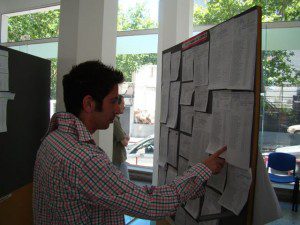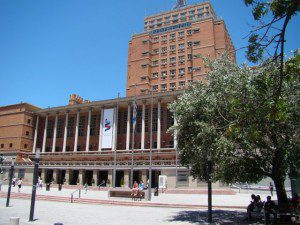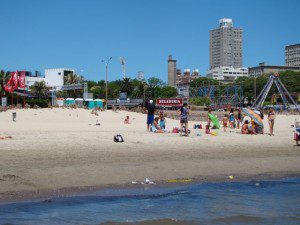Uruguay: Your Questions Answered
I’m in the middle of a two-week residency at Vermont College of Fine Arts, where I received my MFA in Writing for Children and Young Adults in summer 2012 and where I’ve been taken on as a graduate assistant this summer. In this low-residency program, the graduate assistants help introduce the new students, support the graduating students with the technology for their lectures (my principal assignment), and take care of any other duties needed by the program staff. We don’t attend the two-and-a-half-hour workshops, so the six workshop periods are our “free time” and my opportunity to update the blog.
In my review of the film 3 Million, I promised a general introduction to one of the world’s smallest countries, Uruguay. My family traveled to Uruguay in December 2011, turning my son’s business trip to nearby Buenos Aires, Argentina into a family vacation. Uruguay has been in the news in recent weeks because of the World Cup matches in neighboring Brazil and the biting incident involving the Uruguayan star Luis Suárez.
I read a lot of articles about Suárez because the repeat biting incidents, and the contexts in which they occur — not clearly to avenge or to gain an advantage in a fight as with boxer Mike Tyson’s biting of Evander Holyfield — point to a deeper neurological issue (more on that later). Most of the online articles allowed comments. Many of the comments were quite amusing in the questions they asked about Uruguay, so in the interests of spreading the word about this little-known land, I’ve decided to answer some that came up repeatedly.
Where is Uruguay, and why can’t I find it on a map?
Uruguay is a small country on the Atlantic coast of South America, wedged between Brazil and Argentina. Three million people live in a land mass roughly the size of Wisconsin. It was originally considered a buffer zone between Portuguese and Spanish colonies. The best way to find it on a map is to pull up Google maps and type Uruguay. Be sure to zoom out so you can see its location within the South American continent. Now that I’ve revealed this secret, I won’t ever be able to escape a bad situation by going there.
What language do they speak?

We stopped at a university in Montevideo, and Derrick pretended to check his grades. They do not believe in grade inflation.
Spanish is the official language, although the Portuguese influence is evident in the pronunciation, particularly of the letters “j”, “ll”, “y”, and soft “g”, which all have the “jh” sound characteristic of the “j” and soft “g” in Portuguese. (The “y” doesn’t exist in standard Portuguese, and the “ll” does not have the “y” sound that it does in Spanish.)
Besides Luis Suárez, and soccer in general, what is Uruguay known for?
Historically, Uruguay has been known for agriculture and ranching. Some say the sheep outnumber the people. It also has lovely beaches that are favored by tourists from Argentina and Europe, most notably Punta del Este. (We went to Colonia instead because our friends from Argentina said, correctly, that it was much less crowded and still easy to get to.)
Uruguay has one of the strongest economies of South America and information technology is a solid and growing sector. In comparison to its neighbors, the country has a liberal immigration policy and few barriers to starting new businesses. It’s also a relatively cheap place to live, compared with the large cities of other South American economic powerhouses like Brazil and Chile.

The Intendencia (City Hall) of Montevideo was built in the 1940s and reflects the modernist architecture of the mid-20th century.
Isn’t Uruguay known for another type of liberal policy?
Yes. In 2013, the country legalized marijuana, following the legalization in 2012 of abortion and also in 2013 of same-sex marriage. In terms of social issues, the country is the closest one in South America to Western Europe, and the change in this once Catholic-dominated country has been quite rapid. As in Spain and Portugal — both once very conservative but now among the most liberal — the Catholic church lost most of its legitimacy because of its support of repressive dictatorships. Uruguay was ruled by a military junta from 1973 to 1985, and the country’s current president, José Mujica, was tortured and imprisoned for more than a decade during the dictatorship.
Although marijuana has been legalized, there are limits on how much one can possess at a given time, as most Uruguayans don’t want the country to become the kind of drug tourism magnet that the Netherlands has become (and against which the Dutch are now taking measures). I think they’re hoping that most stoners won’t be able to find Uruguay on a map.
Or maybe people will worry that they’ll get bitten. Do people bite each other there?

Montevideo is built on the northern bank of the Río de la Plata, and the city features many beaches as well as parks.
No. In contrast to their Brazilian and Argentine neighbors, Uruguayans tend to be pretty quiet and conservative in their personal lives. People hang out in restaurants and bars and enjoy live music, including a combination of music and theater known as murga. Montevideo has many nice bookstores as well. The booming IT industry has given the city a nerdy vibe that’s cool in its own way. Montevideo has lots of classic nineteenth century architecture in the Old Town and elsewhere as well as parks and beaches.
There’s way too much fresh seafood and tasty meat sandwiches (the chivito, made of thin-sliced beef, mozzarella cheese, tomatoes, olives, and mayonnaise on a bun or roll, is the national specialty) for people to be of interest to diners.

Ever seen a Christmas tree in the middle of summer? Yes, the end of December is summer in most of South America.
Two caveats, however:
Stray dogs are a problem, especially in rural areas. And these dogs do not have their rabies vaccinations, making Uruguay one of the countries on the rabies watch list. It means that if you bring your dog to Uruguay, the animal will be automatically quarantined upon reentering a country (or entering if you adopt a Uruguayan dog) that is not on the rabies watch list. And one should not approach stray dogs in Uruguay, but that generally goes for stray dogs anywhere.
Even though Uruguay is one of the most prosperous countries in the region, there are still great economic disparities, something the government is trying to address. President Mujica and his compañeros went to prison in the 1970s because they sought things like land reform, the redistribution of wealth, and education and healthcare made available to all. Luis Suárez grew up in dire poverty and was living on the streets by the age of 15. He and his family were among those the revolutionaries could have helped had they been in power and not in prison. If the athlete’s biting issues (or cursing and racist remark issues, which could very well be a sign of a neurological condition like Tourette syndrome) emerged in childhood or early adolescence, he certainly did not have the resources to get appropriate diagnosis, treatment, and accommodation.
So if Uruguayans don’t bite, why did they hail Suárez as a hero?
As a small country that started off as a buffer zone, Uruguayans are especially sensitive to getting stepped on. Soccer is their way of having a presence, and Suárez is one of the world’s best and most exciting players. And I think that for many, his struggles represent the bad old days of poverty, underdevelopment, and dictatorship; the guilt at how people were treated then; and the hope that those days are forever behind them. Unlike Portugal’s Cristiano Ronaldo, who also grew up in difficult circumstances but is now posing nude for European fashion magazines, Suárez looks like someone who graduated from the School of Hard Knocks. His fellow Uruguayans are cheering for him not because they think biting is a good thing but because they want to show how much they love him anyway — maybe like parents with their own shortcomings who nonetheless refuse to turn their backs on a troubled child.








Fantastic post, as usual Lyn. I am officially informed thanks to you.
Thank you, Sandra! I hope you get a chance to travel there some day. I know it’s a hike from where you are, but it’s summer during your winter.
Thanks for this in-depth look at Uruguay, Lyn. I had to laugh at this question: “Do people bite each other there?” since that’s been all over the news lately.
The coverage has been kind of silly, which is why I had to offer a more nuanced portrait of the country.
May I use this forum to gather opinions on staying in the Montevideo Old City? My wife and I, both in our 60s, are planning an October trip to Montevideo and are much looking forward to it, but I have encountered mixed reports on 1) the current vitality level of the Old City and 2) how safe it is at night. We are fairly intrepid travelers — we are definitely not looking for a sanitized stay at some all-inclusive beach resort — but nor do we want to feel trapped in our room after dark. I know we will visit the Old City , but might it be best to find lodging in another area?
Thank you for your question! My family visited a few years ago, and we stayed in a modern hotel near downtown and the Old City. We found that they rolled up the sidewalks pretty early, even at the height of the season in early January when it was still light outside. Depending on when you go, the Solís Theater has worthwhile performances (including music and dance) that you won’t see elsewhere; otherwise, your nightlife would be bars, cafes, and restaurants accessible by taxi. And dinner can run very late.
In other words, Montevideo is not Buenos Aires. It has a provincial city feel, especially at night. From my experience, safety is less an issue than the hours attractions are open and the fact that a lot of the nice restaurants and cafes are spread out throughout the city with little public transportation. No matter what, you’ll be taking taxis, so I suggest choosing lodging based on other factors.
It is very clear from this article that the writer only visited Montevideo and Maldonado (punta del este)…I urge people to actually visit the rest of the country to fully understand the rich culture…there is so much more to the country than just Luis Suarez!
Of you can’t find Uruguay on the map you probably next extra geography classes or someone to show you how to use maps…
Uruguay is famous for beef!!!
Marijuana is not available for tourists…you must be registered in a pharmacy or club.
Seafood is not common in all Uruguay…just on the coast (Maldonado) many parts are more inland and do not eat fish at all… everyone eats beef…lots of beef.
Dogs do not have rabbies in Uruguay… However there are ‘vampire’ bats in Uruguay and some bats can carry it and potentially give it to pets if they bite them…but it’s not something most people worry about…when vaccinating your pets it all comes together…if you were bitten by an unvaccinated stray dog…the doctors would not be concerned about rabbies usually.
Please visit Uruguay, it’s an awesome country…but actually leave Montevideo and see the rich culture across the whole country, especially the north of the country!!!
It was a different resort town in addition to Montevideo, but point taken. It’s also why I encourage readers to scroll down to the comments because people raise important issues (like the tendency of tourists to congregate in cities and resort areas), update information (the post is from a trip in 2011, so a bit out of date in 2023), and point to favorite places off the beaten track. I agree that cuisine in Uruguay is meat-oriented, though as a pescatarian, I didn’t go hungry as I did in Slovakia or my late husband said I would have in Kyrgyzstan. Thank you for your comment, Elizabeth — Uruguay is indeed an awesome country!